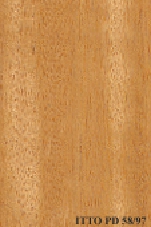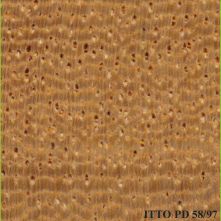
BOSSé CLAIR (Guarea cedrata)
Trade Name
Bossé clair
Scientific Name
Guarea cedrata Pellegr.
Family
MELIACEAE
Common Names
Bosse (Côte d`Ivoire); Diambi (Zaire); Ebangbemva (Cameroon); White guarea; Tshidiamakeka; Tenumeadomei; Telemia; Scented mahogany; Penkwa; Pahiapo; Ossoung; Onwamdua; Obodo blanc; Obobo-nofwa; Nigerian pearwood; Nigerian cedar; Ngbose; Mbosse`; Lombe; Lofun; Kwadwuma; Guissu; Guarea; Edoucie`; Ebangbemva; Ebangbembra; Dzana; Duruiti; Ditoke; Diambi; Cedron; Cedar mahogany; Bossi; Bosse`; Bossassa; Bosassa; Bosae; Bonsannua; Belii; Anokue; African cedar; Edoucie (Cameroon); Obobo (Nigeria); Scented guarea (United Kingdom); Bosse (Germany); Bosasa (Zaire); Obobo nofua (Nigeria); Kwabohoro (Ghana)
Scientific Name Synonyms
Trichilia cedrata A. Chev.; Khaya cunahailata De Wild.; Khaya canaliculata De Wild.; Guarea alitipetiolata De Wild.
Description Of The Tree
Botanical Description
The tree may reach a height of 10 to 16 m. The bole is straight, with widely spaced plank-like buttresses. The trunk diameter attains 30 to 70 cm. Log is banned for international trading.(Cameroon)
Natural Habitat
Guarea cedrata is a timber species found in some abundance in moist semi-deciduous forest and in the drier undisturbed areas of moist evergreen forest. It is reported in thickets on coastal plains, and on riverbanks. National conservation status in Cote
Natural Distribution
Species is widespread in tropical Africa.
Non Timber Uses
Sometimes presence of resin.
Wood Identification
Anatomic Description Of Wood
Wood diffuse porous. Occasionally vessels exclusively solitary (over 90%). Tangential diameter of vessel lumina 100 to 150 micras (small). Non-vestured pits. Vessels per mm2 10 to 20 (abundant). Simple perforation plates. Vessel-ray pits similar to intervessel Axial parenchyma oblique and/or sinuous. Prismatic crystals in chambered axial parenchyma cells and/or in fibers. 5 to 8 cells per parenchyma strand. Axial parenchyma bands over 4 per mm. Rays non-storied. Rays commonly 2 seriate. Silica bodies in the ray cells. Homogeneous rays and/or sub-homogeneous rays (all ray cells procumbent). Body ray cells procumbent with one row of upright and/or square marginal cells (Kribs-III). Occasionally septate fibers present. Fibers with simple to minutely bordered pits.
-
 Wood Macro Photo Radial Plane
Wood Macro Photo Radial Plane
-
 Wood Micro Photo Of Transversal Section
Wood Micro Photo Of Transversal Section
Availability
Cites Status
Unrestricted
General Wood Description
Odor
Pleasant odor.
Color
The sapwood is pale color, it has a thickness of 5 to 10 cm. The heartwood is pinkish brown, it is clearly demarcated. The silver figure is fine (barely visible).
COLOR INDEX (1=Black, 7=Light yellow,white)
6
Grain
The grain is slightly but systematically interlocked.
Texture
The texture varies from fine to medium.
Natural Durability
Durable to decay; this species can be utilized without preservative treatment for exterior joinery or similar uses. Moderately resistant to termites attack. Heartwood is resistant to Lyctus attacks.
Natural durability index (1= Very high durability, 7=Vey low durability)
1
Internal Growth Stresses
No growth stresses are reported in this species.
Silica Content
Silica Content: Silica presence is reported. Amounts over 0.05% may affect wood processing. Silica Value: 0.09
Resistance To Impregnation
Nearly impossible to treat with a too much low penetration of the preservative substances.
Wood Physical Properties
Basic Density or Specific Gravity (O.D. weight/vol. green) (g/cm³)
0.58
Air-dry Density (Weight and volume at 12%MC) (g/cm³)
0.63
Total shrinkage Tangential (Saturated to 0%MC) (%)
6.8
Total shrinkage Radial (Saturated to 0%MC) (%)
4.1
Drying Defects
Ease of Drying: Drying is very slow and difficult to perform; defects are frequent. Drying Defects: Risks of distortions. Kiln Schedules: Schedule proposed as a reference by comparison with well known species taking into account to the general technological behavior of this species.
Recommended Dry Kiln Schedule
FR-6
Dimensional stability ratio (Total Tangential Shrinkage %/Total Radial Shrinkage %)
1.6
Wood Chemical Properties
Wood Mechanical Properties
Bending Strength (MOR),12%MC (kgf/cm²)
966
Stiffness (MOE) 12%MC (kgf/cm²)
128959
Compression parallel to fiber 12%MC (kgf/cm²)
557
Compression perpendicular to fiber 12%MC (kgf/cm²)
72
Shear strength radial 12%MC (kgf/cm²)
85
Janka hardness (side) 12%MC (kgf)
496
Janka hardness (end grain) 12%MC (kgf)
598
Workability
Sawing
It is easy to saw.
Rotary Veneer Cutting
Suitable for slicing, also suitable for peeling if treated.
Sliced Veneer
Suitable for slicing, also suitable for peeling if treated.
Blunting Effect
Moderate blunting effect; stellited blades for sawing and carbide tools for machining are advised.
Machining
Possible difficulties caused by interlocked grain are reported.
Planing
Moderately easy; tools must be cautiously sharpened.
Moulding
Moderately easy; tools must be cautiously sharpened.
Turning
30
Boring
Moderately easy; tools must be cautiously sharpened.
Mortising
Moderately easy; tools must be cautiously sharpened.
Nailing
Pre-boring is necessary.
Gluing
Difficult to glue because of the extracts content.
Sanding
Easy to perform; it gives good results.
Polishing
Can be polished without surface preparation.
Steam Bending
This species can be used for steam bending.
Response To Hand Tools
No particular problems.
REFERENCED USES
End Uses Summary
HOUSING GENERAL, beams, joists, boards, flooring, parquet, frames, steps, panelling, fittings, FURNITURE AND CABINETS, luxury furniture, cabinets, PLYWOOD AND VENEER, faces, Decorative veneer, TURNING, ornaments, turned furniture, NAVAL CONSTRUCTION, boat deck, port storage, OTHER AND MUSICAL INSTRUMENTS, handicrafts, cigar boxes
General Housing
- 10 - Silica in Timbers
Beams
- 11 - Prospect: The wood database
Joists
- 12 - Tropical timbers of the world. Part I-Tropical American Species
Boards
- 13 - Dry kiln schedules for commercial woods. Temperate and tropical. Section III. Latin American (Mexico, Central, and South America) Woods–Conventional Temperatures
Flooring
- 14 - Handbook of Hardwoods
Parquet
- 15 - Empire Timbers
Frames
- 16 - Woods of the World
Steps
- 17 - Tree Conservation Database
Paneling
- 18 - W3TROPICOS Missouri Botanical Garden
Fittings
- 19 - Silica in Timbers
Furniture Cabinets
- 21 - Tropical timbers of the world. Part III-Southeast Asian and Oceanian Species.
Furniture, Luxury
- 22 - Dry kiln schedules for commercial woods. Temperate and tropical. Section IV-Asian and Oceanian Woods
Cabinet
- 24 - Empire Timbers
Panels, Veneers
- 25 - Directory of Timber Trade Malaysia
Faces
- 26 - Annual Review and Assessment of the World Timber Situation 1998-ITTO
Decorative veneer
- 28 - Ministry of Agriculture, Fisheries & Forest of Fiji
Turning
- 30 - Embassy of Honduras in Japan
Ornaments
- 31 - Embassy of Colombia in Japan
Turned Articles
- 32 - Embassy of Cote d`Ivoire in Japan
Shipbuilding
- 55 - Tropical Timber Atlas of Latin America
Boat Decking
- 59 - Programa Nacional de uso Sostenible de los Bosques e Incremento a las Exportaciones.
Port Storage
- 62 - Estudio Tecnológico de Maderas del Perú (Zona Pucallpa) Vol I
Handcraft
- 66 - Maderas latinoamericanas. VII. Caracteristicas anatomicas. propiedades fisicomecanicas, de secado, y tratabilidad de la madera juvenil de Cordia alliodora (Ruiz & Pav. Oken.)
Cigar Box
- 68 - Contribucion al conocimiento de la resistencia mecanica de la madera de peumo
Please Provide Information To View Producer Information